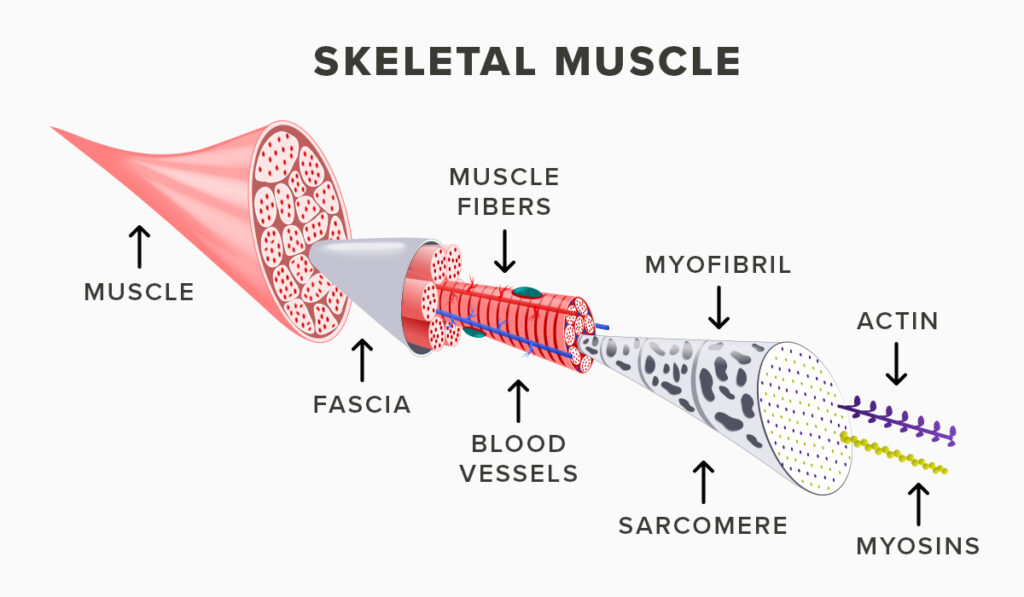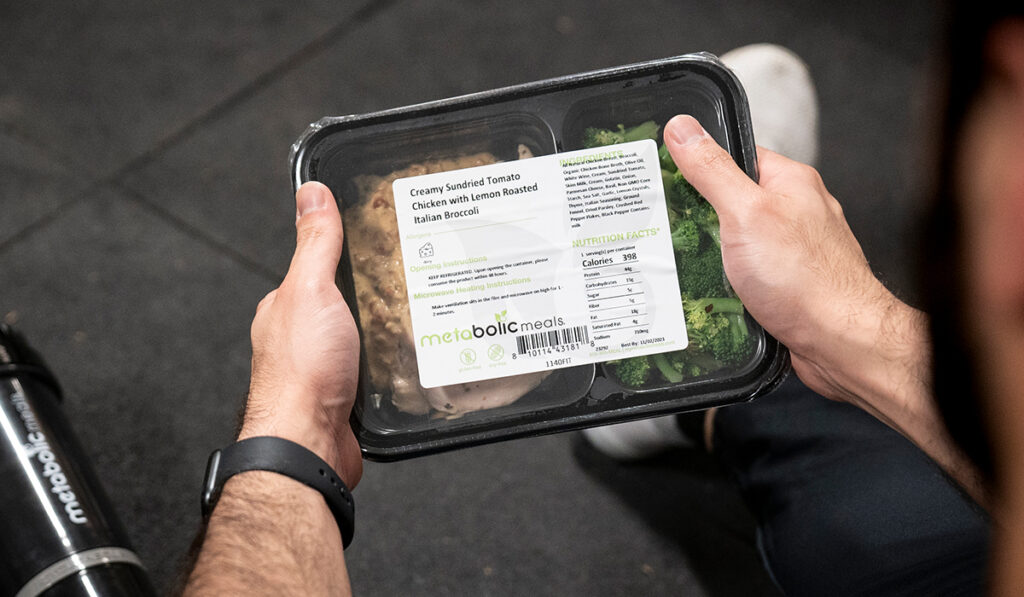
Maintaining and increasing muscle mass plays a crucial role in metabolic health and longevity, critical in increasing the number of calories you burn at rest, improving glucose regulation, and reducing the risk of chronic conditions such as diabetes, obesity, and heart disease. You may not know that skeletal muscle is the body’s largest organ, contributing significantly to metabolic efficiency and better insulin sensitivity. This cannot be more important since less than 20% of the adult population is in good metabolic health.
What makes up your skeletal muscle?

1. Muscle Fibers: These are the long and cylindrical individual muscle cells that contract to produce movement. Each muscle fiber contains smaller structures called myofibrils responsible for muscle contraction.
2. Myofibrils: Found within muscle fibers, myofibrils are made up of repeating units called sarcomeres, the basic functional units of muscle tissue. Sarcomeres contain the proteins actin and myosin, which interact to cause muscle contraction.
3. Connective Tissue: Skeletal muscle is encased in connective tissue that helps distribute force generated by muscle fibers, provides support and protection, and attaches muscles to bones via tendons. This connective tissue includes the epimysium (surrounding the entire muscle), perimysium (surrounding bundles of muscle fibers), and endomysium (surrounding individual muscle fibers).
4. Blood Vessels and Nerves: Muscle tissue is richly supplied with blood vessels that provide necessary nutrients and oxygen and remove waste products. Nerves that control muscle contraction by transmitting brain and spinal cord signals are also integral to muscle structure.
5. Mitochondria: These are the powerhouse organelles found within muscle fibers, crucial for producing the energy required for muscle contraction. The density of mitochondria within skeletal muscle can increase with endurance training, enhancing the muscle’s capacity for aerobic energy production.
6. Satellite Cells: Located on the outer surface of muscle fibers, these cells are involved in muscle tissue growth and repair. They play a critical role in muscle adaptation and regeneration following exercise or injury. Together, these components allow skeletal muscles to contract efficiently, adapt to various demands (such as strength or endurance training), and repair themselves, essential for movement, strength, and overall health.
Why Do We Lose Muscle with Age?

The process of losing muscle mass, known as sarcopenia, typically begins around 30 to 40 years old. From this point onward, individuals can expect to lose approximately 5% of their muscle mass per decade. This rate of decline can accelerate with age, especially in the absence of regular physical activity and proper nutrition.
Hormonal changes play a significant role in this decline. In men, there is a gradual decrease in testosterone levels as they age, which affects muscle mass since testosterone is crucial for muscle growth and maintenance. Lower testosterone levels reduce the body’s ability to rebuild muscle fibers, which are broken down during daily activities and exercises.
In women, the decline in progesterone, particularly around menopause, contributes to muscle loss. This hormone is vital for maintaining muscle mass and strength. Low levels can also lead to decreased muscle density and recovery capacity.
Furthermore, aging is often associated with a systemic rise in cortisol levels, a stress hormone that, when chronically elevated, can lead to muscle breakdown. Cortisol can inhibit protein synthesis and increase protein degradation, further accelerating muscle loss. This hormonal shift, combined with the natural decrease in anabolic hormones like testosterone in men and progesterone in women, amplifies muscle decline. Consequently, maintaining muscle mass as we age requires attention to diet, regular participation in resistance training, and strategies to manage stress and hormonal balance.
Strength Training Can Be Your “Fountain of Youth”

Charles Poliquin and Arthur Jones, both highly influential figures in the world of strength training, have contributed significantly to our understanding of how such training can act as a veritable fountain of youth. Their teachings emphasize the importance of muscle tension and time under tension (TUT) in promoting muscle growth, or hypertrophy, and how these principles can lead to increased longevity.
Muscle tension refers to the force generated when a muscle contracts. According to Poliquin and Jones, for muscle growth to occur, a sufficient level of tension must be applied to the muscles. This tension stimulates muscle fibers, leading to increased strength and size adaptations. The concept of time under tension extends this idea by suggesting that the duration a muscle is kept under strain during a set is critical for maximizing hypertrophy. By controlling the tempo of the exercise and ensuring that the muscle is under continuous tension throughout the movement, one can increase the workout’s effectiveness for building muscle.
The chemical processes seen during hypertrophy training are also crucial to understanding its potential benefits for longevity. When a muscle is subjected to the stresses of proper strength training, it undergoes damage at the cellular level, which in turn triggers a repair process. This process involves the removal of damaged cells and the synthesis of new, healthier muscle fibers. Growth factors and hormones, including human growth hormone (HGH) and testosterone, play a pivotal role in this muscle repair and growth process. These hormones aid in muscle development and have beneficial effects on overall health, such as improved metabolic rate, enhanced mood, better bone density, and a more robust immune system.
Moreover, hypertrophy training can improve insulin sensitivity, ideal for managing blood sugar levels and preventing chronic conditions such as type 2 diabetes and obesity. The increased muscle mass from regular strength training can act as a reservoir for glucose, helping to regulate glucose levels in the body more effectively.
Using Nutrition to Maintain Muscle

Increasing the intake of quality protein to the range of 0.60 to 1 gram per pound of body weight, distributed over multiple servings of 25 to 40 grams throughout the day, is a strategic approach to enhance muscle synthesis, repair, and preservation.
Protein is composed of amino acids, the building blocks for muscle tissue. Consuming adequate amounts of protein ensures the body has a sufficient supply of amino acids to repair and build muscle fibers after they are stressed during activities, especially resistance training. The recommended intake range (0.60-1g per pound) accommodates varying levels of activity, from moderate to highly active individuals, ensuring that muscle repair and growth needs is met.
The rationale behind spreading the protein intake over multiple servings of 25 to 40 grams lies in optimizing muscle protein synthesis (MPS), the process through which the body builds muscle tissue. Consuming protein in this specified range ensures that each meal contributes effectively to muscle repair and growth, maximizing MPS rates throughout the day. Moreover, consistent protein intake in divided doses helps maintain a positive nitrogen balance, which is crucial for muscle development. A positive nitrogen balance indicates that muscle synthesis exceeds breakdown. This is particularly important as we age, since muscle protein synthesis efficiency can decline, making it even more crucial to provide the body with a steady supply of dietary amino acids.
In addition, the quality of protein matters. High-quality proteins contain all essential amino acids in proportions beneficial for human health and are more effectively used by the body for MPS. Rotating sources such as grass-fed red meat, poultry, dairy, eggs, and wild-caught seafood help achieve a balance of amino acids and reduces the likelihood of developing food sensitivities.
Carbohydrates: Friend of Foe?

The amount of highly processed foods consumed by Americans each year is alarming and has undoubtedly contributed to the nation’s high rate of obesity. These foods are highly palatable and rich in poor-quality carbohydrates. This doesn’t mean that you have to eliminate carbs completely. The quantity and timing of your carb sources can be pretty beneficial when adding muscle mass.
Adding carbohydrates before and immediately after resistance training can significantly enhance workout performance and recovery. Consuming a small serving of carbs before exercising, such as eating fruit, honey, or rice, provides a quick energy source. This energy boost is crucial for fueling the body during intense resistance training, allowing for more effective workouts by improving endurance and strength.
Post-workout, incorporating carbohydrates is equally valuable. Immediately after resistance training, the body’s glycogen stores get depleted, and there’s an uptick in cortisol levels, a stress hormone that can break down muscle tissue. Consuming 35g-60g carbs, like cold-pressed juices, a serving of rice, or a few potatoes with a protein source, helps replenish the muscle glycogen used up during the workout. This glycogen replenishment is essential for recovery, allowing the muscles to repair and grow. Additionally, the intake of carbohydrates post-exercise can help reduce cortisol levels by providing the body with the energy it needs, preventing further muscle breakdown, and facilitating the recovery process.
Support your Hormones with Healthy Fats
Healthy fats support hormone production and overall health. Fats are essential components of cell membranes and are crucial for synthesizing and regulating hormones, including sex hormones involved in building muscle. Incorporating sources of healthy fats such as extra virgin olive oil (EVOO), coconut oil, butter, ghee, and various animal sources can positively impact hormonal health.

1. Extra Virgin Olive Oil (EVOO): EVOO is rich in monounsaturated fats and antioxidants like polyphenols. These compounds can enhance the production of hormones that regulate metabolism, such as thyroid hormones, and improve insulin sensitivity. The antioxidant properties of EVOO also protect cells from oxidative stress, supporting overall endocrine health.
2. Coconut Oil: Comprised mainly of medium-chain triglycerides (MCTs), coconut oil provides a unique form of fat that is quickly used for energy and less likely to be stored as fat. MCTs can support the production of ketones, which have been shown to have various beneficial hormonal effects, including the regulation of insulin and an increase in hormones that promote weight loss and reduce appetite.
3. Butter and Ghee: Both butter and ghee are rich in saturated fats, essential for producing sex hormones. They are also good sources of fat-soluble vitamins A, D, E, and K, which are necessary for the synthesis of steroid hormones and for maintaining the health of the reproductive system. Ghee, a clarified butter, is particularly revered in Ayurvedic medicine for its health-promoting properties, including its ability to support hormonal balance.
4. Various Animal Sources: Fatty cuts of meat, organ meats, and fatty fish are excellent sources of essential fatty acids, cholesterol, and fat-soluble vitamins—all critical for hormone production. Cholesterol, found in animal fats, is a precursor for steroid hormones. Fatty fish like salmon provide omega-3 fatty acids, known to reduce inflammation and support the production of hormones that regulate cell growth.

To Recap
A decline in muscle mass as we age does not have to be set in stone. Strength training and proper nutrition can have incredible quality of life benefits. The statistics show that our adult population is over-fed and under-muscled more than at any other time in history. Utilize these tips and reverse the trend of chronic diseases and age-related performance decline.
About The Author: Jason Barbour
Jason Barbour is a highly sought-after strength and nutritional consultant for busy executives and has worked with professional athletes from the NFL, NHL, and UFC, including three world champions and an Olympic medalist. In 2009, Jason started Metabolic Meals, one of the country’s largest healthy meal delivery companies with thousands of customers nationwide.






